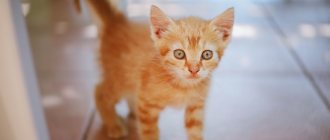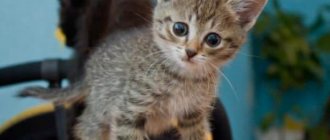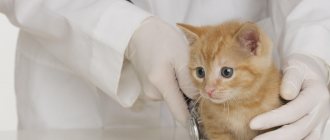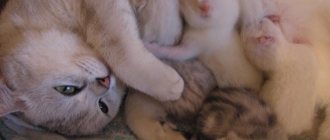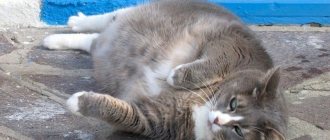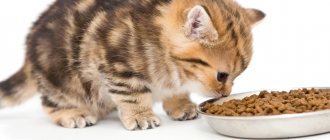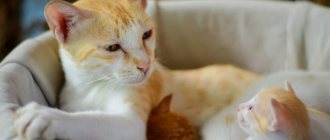Every responsible owner approaches the health of his furry pet with particular seriousness. Understanding that this factor is largely determined by several factors, the owner tries to create the most suitable conditions so that the development of kittens corresponds to all normal indicators. These include proper nutrition, the home conditions in which the animal lives, the presence of other pets in the house, and so on.
Why monitor the development of newborn kittens?
Knowing how a kitten grows and what skills it should acquire by a specific age, you can monitor your own pet. If you notice a deviation from the norm in any indicators in time, it is quite possible to eliminate it in the early stages of the problem.
The stages of growth and development of furry babies, from the moment of birth to one year, are associated with certain patterns. At the same time, each kitten is individual in its own way. Despite the fact that they go through the same stages of growing up, day by day and month by month. But they are all so different that it is impossible not to notice it even among the offspring of the same mother cat.
So, it should be noted that the first three months of a kitten’s life pass quite quickly for him. He is growing up quickly and gaining weight. This period is decisive in its further existence and development. Having overcome a kind of “critical” age threshold, most likely, everything will be fine in the future.
What should owners be wary of?
Care and attention are the most important things kittens need at this age. It is important not to miss the following points in the condition of a kitten up to 3 months:
- does not gain weight well;
- sleeps separately from the nursing cat and the rest of the litter of kittens;
- looks noticeably weaker than them;
- his mother ignores him;
- the kitten often experiences vomiting and diarrhea;
- discharge from the eyes, nose, anus.
If kittens have at least one of the above signs of pathology, they must be urgently shown to a specialist.
What happens when you purr?
In general, purring is a vibrating, rhythmic and often quite long-lasting sound made by animals. As a rule, all representatives of the cat family purr. But some other animals, such as hyenas, mongooses, badgers and even bears, can also make similar sounds.
What happens during purring? For a long time, zoologists and scientists could not understand how cats purr, since there is simply no organ responsible for this process in the body of cats. But still, in the course of recent studies, it was found that cats begin to purr as a result of certain electrical impulses arising in the brain.
These impulses then travel along nerve endings to the muscles located next to the vocal cords. But muscles cannot make such sounds. And here the hyoid bones come into play, finely interconnected and located between the base of the tongue and the base of the skull.
Muscle contractions provoke vibration of these very bones, which results in the purring sounds that we all hear. Such sounds come from the animal's nose and mouth, but the vibrations spread throughout the body. And they arise both on exhalation and on inhalation. It is interesting that only small cats can purr; the structure of the hyoid plates of large ones is somewhat different, so they can only growl (and sometimes grunt or grumble).
By the way, if a cat starts purring at a veterinarian’s appointment, then he cannot listen to her lungs and heart. During the research, some characteristics of purring were also clarified. So, the frequency is approximately 22 to 24 hertz.
The first days after birth
There is probably no person who does not know that newborn kittens are absolutely defenseless. They are born tiny, like little mice, blind and deaf. The only thing they need in the first weeks is their mother. She is with them almost around the clock, leaving only occasionally to eat and relieve herself. Based on the first two weeks of kitten development, it is difficult to imagine what they will look like as adult animals. Their eyes are almost completely closed, and their tiny ears seem to be neatly folded.
It is worth noting that for a kitten in the first days it is extremely important that the cat be nearby. Thermoregulation in babies is imperfect; their bodies can quickly become hypothermic or, conversely, overheat. Mom helps maintain the optimal temperature in the place where their newly-made family is located.
On the 5th-6th day, the withered umbilical cord of the furry babies falls off. Eating, sleeping and periodically defecating are all they do in their young age. The cat tries to lick each kitten: thus, she cares for the offspring, maintaining hygiene and giving them regular abdominal massages, which helps stimulate sufficient excretion of feces and urine.
Cat Behavioral Signals
To the question of where the purr is located in cats, we were answered by scientists' theories, but what prompts cats to make this sound, why do cats purr when you stroke them, what prompts animals to do this? Or why do cats purr in response to stroking from a stranger? The answers to these and other questions related to cats can be found below.
Little blind kittens, when suckling their mother's breast, make a purring noise while feeding, thereby signaling to their mother that they are healthy and eating with pleasure.
Mothers, when communicating with their children, kittens, purr, thereby informing them that she is nearby and is always ready to help and protect her offspring. Read the article about caring for cats and newborn kittens.
This is an antidepressant for the cat itself; thanks to purring, it calms down in some uncomfortable situations. This neutralizes the cat's nervous excitement, gradually returning it to its normal state, calming the animal.
A feeling of gratitude, a kind word, stroking, a piece of treat that the animal received from the owner, all this causes the pet to react, as a result of which he purrs, expressing his gratitude.
Purring helps a cat fight illness by activating blood circulation and metabolism, and even helps the animal improve its heat exchange if it is very cold.
Greeting: Cats purr when meeting new people or other animals and members of their own species.
This shows that they are not aggressive, but kind, and reveals the character of the cats (whether the animal is a contact person or whether it is worth paying attention to problems in psychology).
Extortion: cats often use this technique in an effort to achieve what they want, either to get a tasty piece of forbidden sweets, or asking for another dose of caresses and strokes from the owner.
To achieve internal balance before bed, the timbre of purring allows the cat to relax, this helps to get a good night's sleep and gain strength.
A cat makes a loud, threatening purr when something threatens the animal itself, or someone encroaches on food or territory. At such moments, the pet becomes tense, the tail trembles, and if you try to touch the animal, you can get quite a bit of damage from the claws.
Sometimes purring can be heard from a cat while playing, holding a toy in its paws or watching it from an ambush, the animal makes soft rumbling sounds, this is a manifestation of the hunting instinct of its ancestors, which is inherent in every cat, no matter whether they are domestic or wild.
For a true cat lover, there is no better music than the gentle purring of a pet, its contented, muffled purr. It has long been believed that representatives of the tailed-striped family make these sweet, soothing sounds when they are at the height of bliss. But is this really so?
Just watch the cute furball for a little while and you will immediately notice that your kitten makes purring sounds not only when you pet him. With them he greets his mother, begs for food, and responds to pleasant dreams.
Even reputable scientists decided to understand why kittens purr. Together with eminent veterinarians, they found out that very often animals relieve stress or anxiety with this sound, calm themselves, and find inner balance.
In addition, the researchers made several startling assumptions, including:
- This is how kittens maintain normal muscle tone;
deep guttural vibrations create a healing effect - bones grow faster in animals and wounds heal in case of injury. This also explains the “medicinal” effect of cats on their owners.
As it turns out, purring is not always an indicator of a cat’s positive emotions or good mood. Sometimes it is a “sedative” during a difficult period for the animal. But an attentive owner can easily distinguish a gentle rumbling from nervous, excited sounds.
Second week of life
At 10 days of age, babies' visual organs begin to open and their first hearing abilities appear. They already confidently respond to sound sources, the most significant of which for them can be called the meowing of a cat. Indeed, by 2 weeks, babies’ eyes are open, but their vision is still difficult to call clear: they see everything blurry and fuzzy.
The further development of kittens can be negatively affected by their separation from their mother at such an early age. In the first weeks after birth, for every baby, a cat is not only care, warmth and protection (including immune protection, with the help of antibodies that they receive in regular portions of colostrum and milk). Separation will also negatively affect the pet’s future relationships with people, other animals, and its learning abilities.
Purring mechanism - how do cats purr?
For a very long time, many zoological scientists struggled with the riddle
organ responsible for a cat's purring.
The rumbling is associated not so much with the internal organs of the cat, but with its brain activity.
At first it was believed that the rumbling was produced by the stomach, then theories were put forward that the cat has a special “purring” organ next to the spleen.
For many years, research on animals led to nothing, until one of the scientists put forward a hypothesis according to which rumbling is associated not so much with the internal organs of a cat, but with its brain activity. And indeed, the animal’s brain sends certain impulses to the body, as a result of which this enchanting sound is heard.
Where does the sound come from?
The cat's hyoid bones interact with the vocal cords to produce a purr.
But the question still remained open, which organs are responsible for the physical transmission of sound in space.
The answer was found just a few decades ago - the thin hyoid bones of a cat interact with the contracting vocal cords as a result of a signal received from the brain. It is this interaction that creates such amazing sounds that the animal can use at its discretion.
Kittens at three and four weeks of age
By the beginning of the third week, small fluffy balls usually begin to emit the first purr, the picture of the visual field of any kitten becomes definite: visually they will already be able to find their mother. After a week, the development of the organs of hearing and smell ends, and the ears take shape. In addition, kittens at the age of 3-4 weeks take their first hesitant steps and pay attention to their sisters and brothers. At the same time, their baby teeth appear, the incisors emerge first, followed by the canines, premolars and molars.
At 4 weeks, you don’t have to worry about the fact that it’s too early to introduce your young pet to the toilet. It is advisable to take care of the baby and, just in case, purchase a litter tray designed for kittens. They often perceive it either as food or as a toy. Ordinary contents of the litter tray may be harmful to the animal if swallowed (for example, silica gel).
A few necessary recommendations
It is difficult for your kitten to feed himself if the dishes are awkward or large, so you should choose dishes that are the right size and that are stable on the floor. This way the baby will feel more comfortable and will eat more willingly.
Don't forget the following simple rules:
- A saucer of water should be placed near the bowl of food.
- You cannot force a kitten to eat.
- Do not mix dry food with regular food. This can only be done when switching from one food to another.
On a note! The kitten will refuse food that is too hot or, on the contrary, cold . Food should be at room temperature.
Beginning of the second month of life
In the fifth week, the crumbs become simply unrecognizable. It seems that these “hooligans” have nothing in common with those motionless babies who were located in the nest about a month ago: they already run deftly, improve their sense of balance, can bypass obstacles, sneak up from behind and attack. By this time they are already showing concern for each other.
5 weeks is a turning point in the kitten’s nutritional system. At this age, you can try offering him complementary foods. The ideal supplementary diet (the main one is still cat milk) is canned food for kittens.
Peculiarities of behavior of kittens aged 1.5-2 months
After a couple of weeks, by the middle of the second month of life, they still bear little resemblance to adult lazy cats. Kittens constantly communicate, move actively, run, play, and sharpen their nails. A month and a half is a great time to get your first worm vaccination. If there are potentially dangerous objects in the house within easy reach of animals, it is better to remove them. This is about:
- all kinds of chemicals, detergents;
- first aid kit with medications;
- needles, pins, pushpins;
- electrical outlets;
- poisonous indoor plants, etc.
If the pet, at the request and insistence of the owner, is expected to engage in grooming in the future, then the basics of this area must be taught at 7-8 weeks. You should start with simple procedures, let the baby get used to bathing, combing fur, and cutting nails. Of course, by 2 months his claws have not yet become dangerous to others, like those of an adult animal, so there is no need to really trim them. It is important at an early age to accustom the kitten to the position in which this procedure will then take place.
At 8-9 weeks, all baby teeth are usually in place. With breastfeeding, many owners try to separate the babies and completely switch the kittens to “adult” food. Games and contact with people are especially important for small pets, so it would be better if all family members find at least 15-20 minutes every day to communicate with their pet.
What if the cat doesn't purr?
As already noted, everyone purrs. But what to think if the cat doesn't do this? This can be quite a warning sign that there are problems. Carefully examine the animal to rule out the possibility of illness or illness.
The pet is probably just not in the mood. Try to pick him up, stroke him, talk to him kindly. If there is no purring for a long time, take your cat to the vet. The absence of purring may indicate problems with the ligaments or even with brain function.
It was noted above that during vibrations the doctor cannot listen to the heartbeat. But many veterinarians use an interesting technique. They turn on the water tap, reducing the pressure to a minimum. The sound of a trickle of water is probably similar to the vibrations produced by the hyoid bones. And when a cat hears such a sound, it stops purring.
Now you have learned a little more about such seemingly native, but at the same time absolutely unknown and unpredictable animals like cats. Let your pet always please you with his purring.
In every home where a cat lives, any family member knows that there is no better consolation after a difficult and difficult day than the purring of a pet. These gentle grumbling sounds, which are similar to the work of a small tractor inside, are made by cats before they even open their eyes, literally from the cradle. This is a way to talk to a person. Why do cats purr, what do they mean by this? Is this a way of cuddling or is the cat telling you how your day went? There are several versions of the origin of such a pleasant sound.
The process of purring begins in the brain, which, as a result of external influences with the help of impulses, gives a signal to the muscles of the vocal cords, which produce vibration as a result of which purring occurs.
To the question: why do cats purr, there is another physiological theory: the reason is in the special structure of the larynx, namely the so-called hyoid bones; when these bones move, vibrations occur, which cause characteristic sounds.
Some scientists believe that a cat itself can cause purring by contracting the muscles of the larynx in a special way during the breathing process.
Development in kittens after three months of life
After three months of age, it is difficult to notice radically noticeable changes in the development of furry babies. True, they grow intensively for up to six months. From 12 weeks to 6 months, they undergo natural preparation for independent living, acquiring fundamental skills and abilities through constant play.
During this period, a feature of the psychological development of almost sexually mature adult cats is the building of a hierarchy. The determination of the leader and subordinate members of their society, which includes people, is an essential component of the relationship between animals of a given species and other inhabitants of the house. It is not surprising that upon reaching 6 months of age, having grown stronger and gaining sufficient confidence in their own abilities, they test the limits of what is permitted, often challenging the owner.
What are the benefits of a cat's purring for humans?
A cat in the house is a living anti-stress. In any case, many owners are sure of this. Indeed, the purring of an animal is very calming and even lulls you to sleep. But cats are also real healers. Let's list what miracles they can create only with the help of their purrs, based on research by Californian scientists:
- Cat sounds, usually made at a frequency of 27-44 Hz, help strengthen bone tissue;
Frequent communication with domestic cats is indicated for people suffering from nervous disorders;
Regular listening to cat songs helps strengthen the immune system, which means it prevents frequent illnesses;
The sounds of purring improve a person’s cerebral circulation, normalize blood pressure, and calm a rapid pulse;
Hunger
A kitten may give a vocal signal for a completely natural reason: it is hungry. This is the most common reason why animals meow. This applies to both children and adult pets. First of all, any living organism tries to satisfy its nutritional needs. And the kitten, once in a new place, first learns where the “food source” is located. Not finding food, the small animal begins to worry, and then declares its needs to the person.
It is advisable that there is always some food in the bowl; this will save the owner from constant plaintive cries.
In some cases, the cause of meowing is pseudo-hunger. That is, the kitten is full, but with the help of its voice it tries to beg for tidbits. Usually this characterizes the pet in a certain way: he wants to dictate conditions, tries to beg for something tasty, and thereby force the person to follow his lead. As with children, you need to be firm. You cannot indulge your pet's first desire. This does not mean that an animal should not be pampered at all, but in childhood this is especially fraught with consequences. If a person does not want to constantly endure impudent extortion from the cat, then he should make it clear from the very first attempt who is boss in the house. The pet must understand that nothing will be given to him upon request, and the decision as to whether he will receive a treat or not will be made solely by the “senior”.
4–5 months: adolescence
The nutrition of a growing pet should consist of kitten food, which contains substances necessary for normal development. It is recommended to feed animals about 5 times a day. By the end of the fifth month, a three-times-a-day diet is established.
The appearance of the kitten changes, its body increases in size, its muzzle and tail lengthen, and its paws stretch. The pet can already be mistaken for an adult cat, he plays less with toys, sleeps more and strives to communicate with people. At 5 months, the kitten’s baby teeth begin to fall out and permanent teeth begin to grow.
Measures to ensure the safety of a kitten starting to eat on its own
The baby’s safety while learning to feed himself is a very important aspect:
- Distracting and frightening moments should be eliminated.
- The food itself must be safe, that is, fish, for example, should be thoroughly cleaned of bones; it is strictly forbidden to give river fish: there is a risk of helminth infection.
- The meat should be cooked or pre-frozen for 2-3 days (this will get rid of possible parasites).
- The pieces of meat must be chopped so that the baby does not choke and can chew them well.
- Dry food should be strictly according to age (for kittens, granules are made smaller).
Food manufacturers take into account both the needs and characteristics of kittens, producing special products for them
2–3 month old baby: development, first vaccinations
By 7–8 weeks, the color of the iris becomes constant. Animals that have been trained to use a litter tray begin to look for it on their own, so they rarely make puddles in the wrong place. This is the right time to look for new owners.
The weight of a two-month-old kitten, depending on the breed, ranges from 400 to 900 g. This is the period when mother’s milk ceases to be an integral part of the daily diet of older babies. They occasionally cuddle with their mother to feast on her and feel her warmth and care, but the animals feed on their own. For a two-month-old pet, feeding five times a day is optimal. Water must always be available.
At 2 months, pets begin to purr if they enjoy petting. Kittens become extremely active, they get into the most inaccessible places, they can run out the door and end up on the street. The owner should be especially careful when leaving the house.
At 2.5 months, babies receive their first vaccinations. However, if there is a risk of early infection with dangerous infections, then vaccination is carried out earlier than 8 weeks.
A three-month-old kitten has a well-developed musculoskeletal system, he knows where his bowl and tray are, and willingly comes running when his name is called. The body weight of a three-month-old cat is about 1.3 kg.
Drinking regime
It is unnatural for cats to drink a lot of water. They have evolved in such a way that their water needs are almost completely satisfied by the moisture content of their food. So don't worry if your kitten seems to quench its thirst very quickly.
The daily water requirement for a kitten is calculated using a simple formula: body weight multiplied by 0.03. The resulting value includes the water contained in the feed. How much moisture is in the food is indicated on the product label as part of a guaranteed analysis. The moisture content is very different between wet and dry food and the owner should take this into account when feeding the baby.
The kitten must have access to clean water
Give your kitten clean, filtered water. The stale smell will scare the baby away and he will not drink. Also, milk and any other liquids other than water will not work.
Cats like wide bowls because they don't like their whiskers touching anything.

